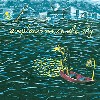 One of the problems with having reached the pinnacle of composition on the album prior is that expectations are high, everyone is looking, and your songs can now be heard every Wednesday on NBC. But Explosions in the Sky marches onward, undeterred by such expectations.
One of the problems with having reached the pinnacle of composition on the album prior is that expectations are high, everyone is looking, and your songs can now be heard every Wednesday on NBC. But Explosions in the Sky marches onward, undeterred by such expectations.
Temporary Residence
They experimented a little with their submission to their label's Travels in Constants series, tinkering with fewer dynamics, more restraint, and even some original dialogue about their broken-down van (the van is, I believe, the conceit of the entire EP.) All of a Sudden I Miss Everyone incorporates what sounds like vestigial themes from the EP but decorates them in more typical explosiony fashion. The concentration and deliberation, the anguish and triumph, the celestial swells and swoops; all of it is here.
"The Birth and Death of the Day" germinates in low-powered static for thirty seconds until it unleashes amniotic fluid all over the place with one concussive punch. The tide then ebbs into a soft marching theme which, in turn, grows into a loud marching theme once the drums decide to make it their own. Is this the musical portrait of one day's arc, as suggested by the title? If so, I hesitate to embrace this as my typical day. The vicissitudes are too harsh, too steep. My day has (and needs) more constancy and steady plateaus. But as a song, it gets me, as Pat Benatar might agree, all fired up. This introduction bleeds into "Welcome, Ghosts," the song which sounds closest to those from the The Earth is not a Cold Dead Place. It is a study in acceleration and deceleration. The song winds up and winds down endlessly, dropping away and returning without warning.
Imagine when you first learned how to drive a manual transmission. Put that to music, perhaps a little more elegantly and sustained, and you have the song. "It's Natural To Be Afraid," the album's centerpiece, is also its longest offering, though the first five minutes feel more like exposition than full-fledged song. It's going to become a live favorite for the band, if not already, because it has plenty of parts for band members to fall to their knees and bang the hell out of their instruments. "What Do You Go Home To?" has an eerie resemblance to the last scene of Heat where Pacino is chasing Deniro all over the airport and a Moby song, one where he tries too hard to be Brian Eno, is playing loud enough to drown out the airplane engines. The periodic cascading piano recalls both the song and the scene and I think I might be doing some horrible injustice comparing Explosions in the Sky to Moby but what I think I am trying to say is that I sort of like the sound (of both of them, embarrassingly) even though the Explosions piece seems more like a tendon or ligament between songs than its own fully-wrought piece. It joins up to "Catastrophe and the Cure," the album's best song which busts through the door, sits down for a cup of tea, and then frenetically runs around the room for the next two minutes. The song necessitates the demulcent piano coda of "So Long, Lonesome" at the end of the album just to come down from the ecstatic peaks of "Catastrophe."
As Explosions evolves, the albums they are creating more closely mimic the band's live performances, where they have acquired acolytes more devoted than Attis. Interludes are more structurally built into the longer songs and some songs have become interludes unto themselves; turn on the stereo and switch off the lights and you have a home-concert. For anyone who has seen the band live, this is what you would wish: to capture just a fractional essence of an Explosions show, bottle it, and toss it into the album cover's city-devouring, wine-dark ocean.
samples:
Read More

